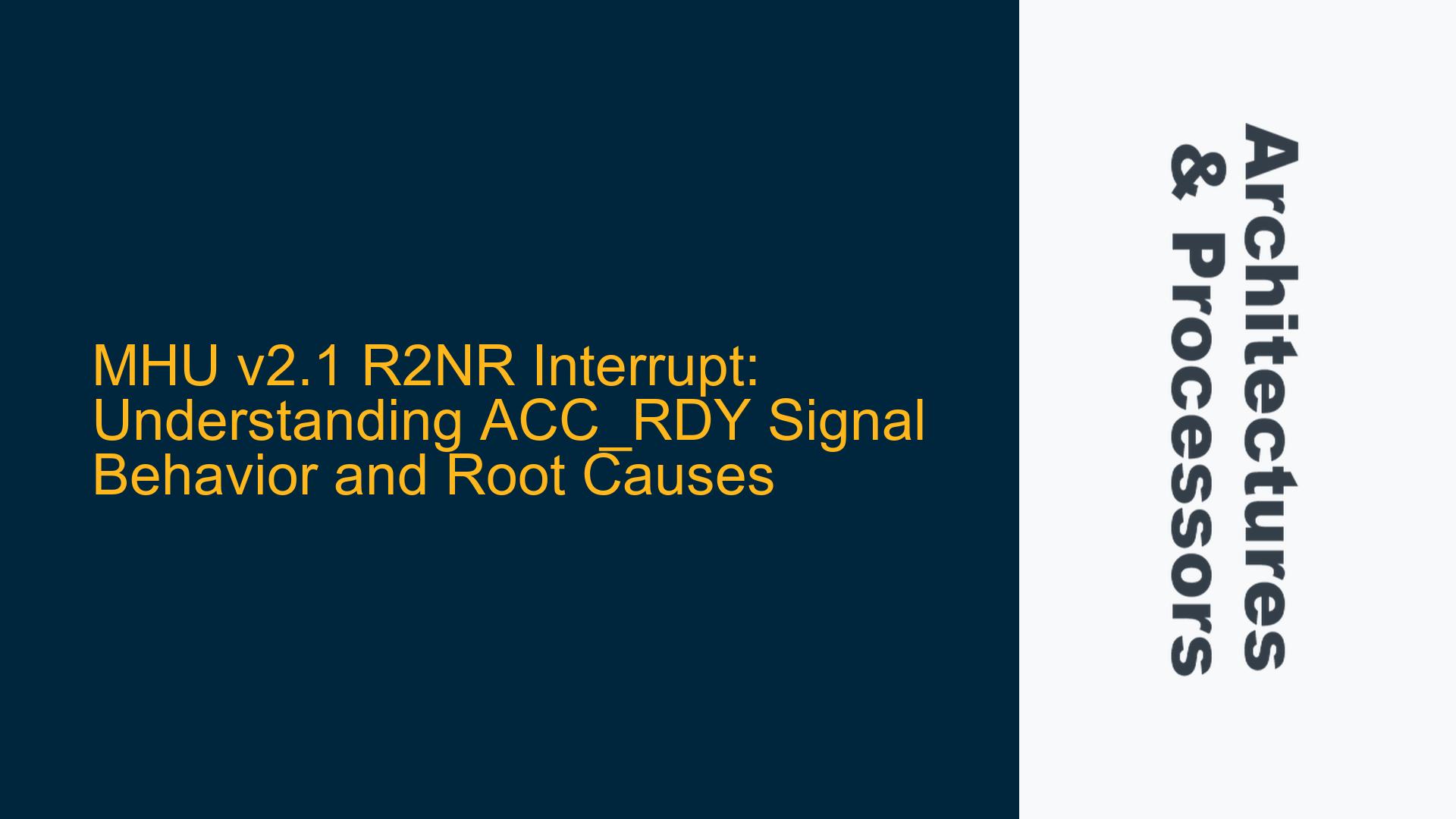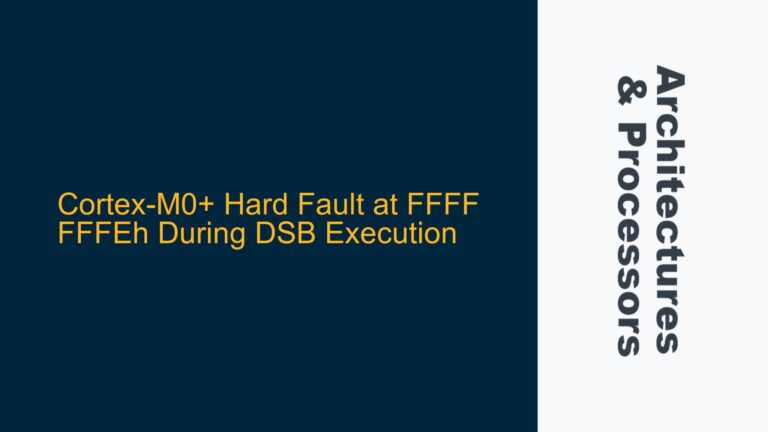ARM Corstone SSE-700 MHU v2.1 R2NR Interrupt Trigger Mechanism
The ARM Corstone SSE-700 subsystem integrates the Message Handling Unit (MHU) v2.1, a critical component for inter-processor communication (IPC) via mailbox mechanisms. The MHU v2.1 supports multiple interrupt types, including the Receiver-to-Non-Receiver (R2NR) interrupt. The R2NR interrupt is triggered when the ACC_RDY signal transitions from HIGH to LOW. However, the ARM documentation does not explicitly detail the conditions under which ACC_RDY goes LOW, leaving developers to infer the root causes and behavior.
The ACC_RDY signal is a handshake signal in the MHU v2.1 architecture, indicating the readiness of the receiver to accept data. When ACC_RDY is HIGH, the receiver is ready, and when it goes LOW, the receiver is no longer ready to accept data, triggering the R2NR interrupt. Understanding the conditions that cause ACC_RDY to transition is essential for diagnosing and resolving issues related to the R2NR interrupt.
The MHU v2.1 architecture is designed to facilitate communication between multiple processors or subsystems in a robust and efficient manner. The R2NR interrupt is one of several mechanisms to ensure that data transfer is synchronized and reliable. However, the lack of explicit documentation on ACC_RDY behavior can lead to confusion and misconfiguration, particularly in complex systems where multiple interrupts and handshake signals are involved.
Potential Causes of ACC_RDY Signal Transition to LOW
The ACC_RDY signal transitioning to LOW can be attributed to several factors, including receiver buffer overflow, misconfigured interrupt priorities, improper handling of handshake signals, and hardware or software timing issues. Each of these factors can disrupt the normal operation of the MHU v2.1 and lead to unexpected R2NR interrupts.
Receiver buffer overflow is a common cause of ACC_RDY going LOW. When the receiver’s buffer is full, it cannot accept additional data, causing ACC_RDY to transition to LOW. This condition is typically temporary and resolves once the buffer is cleared. However, if the buffer is not cleared promptly, it can lead to repeated R2NR interrupts and degrade system performance.
Misconfigured interrupt priorities can also cause ACC_RDY to go LOW. If the R2NR interrupt is not prioritized correctly, it may be delayed or ignored, leading to a situation where the receiver is unable to signal its readiness in a timely manner. This can result in ACC_RDY remaining LOW for extended periods, triggering repeated R2NR interrupts.
Improper handling of handshake signals is another potential cause. The MHU v2.1 relies on a series of handshake signals to coordinate data transfer between the sender and receiver. If these signals are not managed correctly, it can lead to a breakdown in communication, causing ACC_RDY to go LOW. For example, if the sender does not wait for ACC_RDY to go HIGH before attempting to transfer data, it can cause the receiver to become unready, triggering the R2NR interrupt.
Hardware or software timing issues can also contribute to ACC_RDY transitioning to LOW. In systems with tight timing constraints, even minor deviations can disrupt the handshake process. For example, if the receiver takes longer than expected to process data, it may not be able to signal its readiness in time, causing ACC_RDY to go LOW. Similarly, software delays or inefficiencies can lead to similar issues.
Diagnosing and Resolving ACC_RDY Signal Issues
To diagnose and resolve issues related to the ACC_RDY signal and R2NR interrupt, developers should follow a systematic approach that includes verifying buffer management, configuring interrupt priorities, ensuring proper handshake signal handling, and addressing timing issues.
First, developers should verify that the receiver’s buffer is being managed correctly. This involves ensuring that the buffer is cleared promptly after data is processed and that there is sufficient buffer space to accommodate incoming data. If the buffer is consistently full, it may be necessary to increase its size or optimize the data processing routine to reduce latency.
Next, developers should configure interrupt priorities to ensure that the R2NR interrupt is handled promptly. This involves setting the appropriate priority level for the R2NR interrupt in the interrupt controller and ensuring that it is not masked or delayed by other interrupts. If the R2NR interrupt is not prioritized correctly, it can lead to ACC_RDY remaining LOW for extended periods, triggering repeated interrupts.
Proper handling of handshake signals is critical to preventing ACC_RDY from going LOW. Developers should ensure that the sender waits for ACC_RDY to go HIGH before attempting to transfer data. This can be achieved by implementing a polling mechanism or using interrupts to signal when ACC_RDY is HIGH. Additionally, developers should verify that all handshake signals are being managed correctly and that there are no conflicts or race conditions.
Addressing timing issues requires a thorough analysis of the system’s timing constraints. Developers should use tools such as logic analyzers or oscilloscopes to measure the timing of handshake signals and identify any deviations from expected behavior. If timing issues are identified, developers may need to adjust the system’s clock settings, optimize software routines, or implement additional synchronization mechanisms to ensure that handshake signals are managed correctly.
In some cases, it may be necessary to modify the hardware design to address ACC_RDY signal issues. For example, if the receiver’s buffer is consistently full, it may be necessary to increase its size or implement a more efficient data processing routine. Similarly, if timing issues are identified, it may be necessary to adjust the system’s clock settings or implement additional synchronization mechanisms.
By following these steps, developers can diagnose and resolve issues related to the ACC_RDY signal and R2NR interrupt, ensuring that the MHU v2.1 operates reliably and efficiently in the ARM Corstone SSE-700 subsystem.






